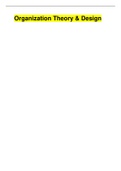Summary
Summary Organization Theory & Design (Very Reliable Study Guide)
- Course
- Institution
- Book
Organization Theory & Design Week I Chapter 1 – Organizations and Organizational Effectiveness What is an organization? Organization Theory & Design An organization is a tool people use to coordinate their actions to obtain something they desire or value. And that is to achieve their goals...
[Show more]



